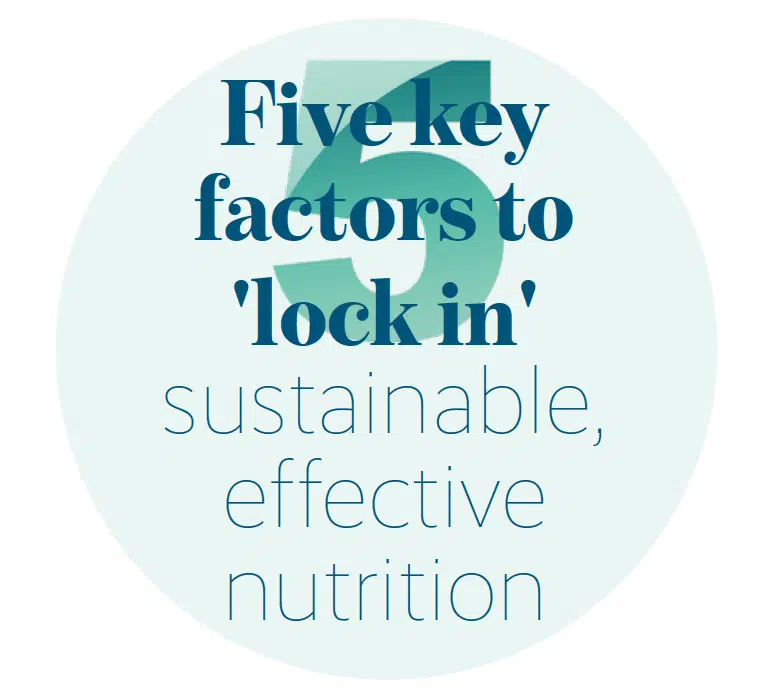Over the years, great strides have been made in the livestock industry, resulting in improvements in animal production. Five factors are considered crucial to lock in sustainable, effective nutrition. These factors should not be considered individually, but rather as interlinking components aimed at achieving a common goal; an improvement in overall production on the farm. Just like a rusty chain, a poor lock, or sagging hinges will cause a farm gate to malfunction, weaknesses in any of these five areas could cause the so-called nutritional gate to break down.

1. Animal performance
Animal performance parameters are what we base most decisions relating to the production system on. When considering performance parameters, emphasis is placed specifically on improving feed efficiency, with smaller numerical values for feed conversion ratios indicative of improvement. These ratios are obtained by measuring feed intake as well as average daily gain (ADG) values. By either increasing ADG values or reducing feed intake, feed efficiency (feed conversion ratios) will be improved. This effectively reduces input costs (feed) per kilogram of product (meat or milk) produced. This links to other components in the system; environmental conditions should be as best they can be for the specific situation to ensure optimal feed intake and promote animal health, which will resonate in animal growth.
2. Food that fuels profit
Purchasing feed ingredients or feeding a product that is economically viable to your farming operation is crucial. In some cases, sustainable, effective nutrition may entail considering the use of a slightly more expensive alternative, be it a feed additive or feed ingredient, in order to reach improved levels of production and, therefore, efficiency. This is given that the outputs (product) of the system trump the inputs (operation costs); therefore, the production system remains economically profitable.
3. Anticipate animal health
Animal health plays an important role in the production levels realised. The prevention of health disorders, which are often linked to nutritional and environmental conditions such as rumen, lung, and liver lesions, are imperative to consider. The increased incidence of these health disordersindicates a disruption in the normal functioning of the gastrointestinal system or environmental conditions that are suboptimal, whereby nutritional aspects (influencing the functioning of the gastrointestinal system) are easier to control than environmental conditions. Therefore, ensuring adequate adaptation periods when transitioning between different diets, adhering to a feeding schedule (therefore preventing overeating or selective feeding), as well as implementing an effective vaccination schedule at the arrival of new livestock or during the annual production cycle (dependent on the specific production system), could contribute to prevention. Little benefit is achieved when a potential production-enhancing diet is fed, that cannot be used efficiently by the animal due to its adverse ruminal and intestinal absorptive capacity or, alternatively, owing to a weakened immune system.
4. Environmental aspects
Animal production and nutrition should be focused on an environmentally friendly, sustainable approach. This means feeding in such a way to reduce the outputs into the environment, be it reducing the concentrations of nutrients in manure or reduced greenhouse gas emissions from livestock, such as methane. Considering the use of feed ingredients in order to optimise digestion and absorption in the entire digestive tract is key. How we achieve this? One way could be to feed a balanced diet, meeting the maintenance or growth requirements of the animal without oversupplying certain nutrients. Manure handling and disposal in intensive systems should be done in such a manner to minimise carbon and methane release, thereby reducing the carbon footprint of the system.
5. Good management = sustainable production
Managing and prioritising daily activities as well as facility design could influence animal production. Cleaning water troughs (as required) should form part of the regular routine. Providing clean, fresh water will have a beneficial impact on animal productive performance. Animal handling during processing, transportation, and movement through facilities should be managed to prevent productive losses. Facilities on-farm should be designed to ease animal movement and provide comfort. Implementing cooling systems or providing enough shading in areas where animals are exposed to extreme temperatures will reduce heat stress. Heat stress can lead to reduced feed intake, adversely affecting animal performance. Facility design should aid animal movement, prevent injury to animals or staff, and reduce stress. As part of good management practices, specific camps or pens should be allocated for sick animals that are treated and monitored on a regular basis. This, in turn, links back to animal or herd health, with quarantining of sick animals preventing the spread of disease and possible production loses within the herd or flock.

Conclusion
Good practical management, maintaining and improving animal health, considering environmental impacts, calculating profitability, and monitoring animal production will optimise any sustainable, effective nutrition system and give the enterprise the potential to be successful.
Ruminant researcher










